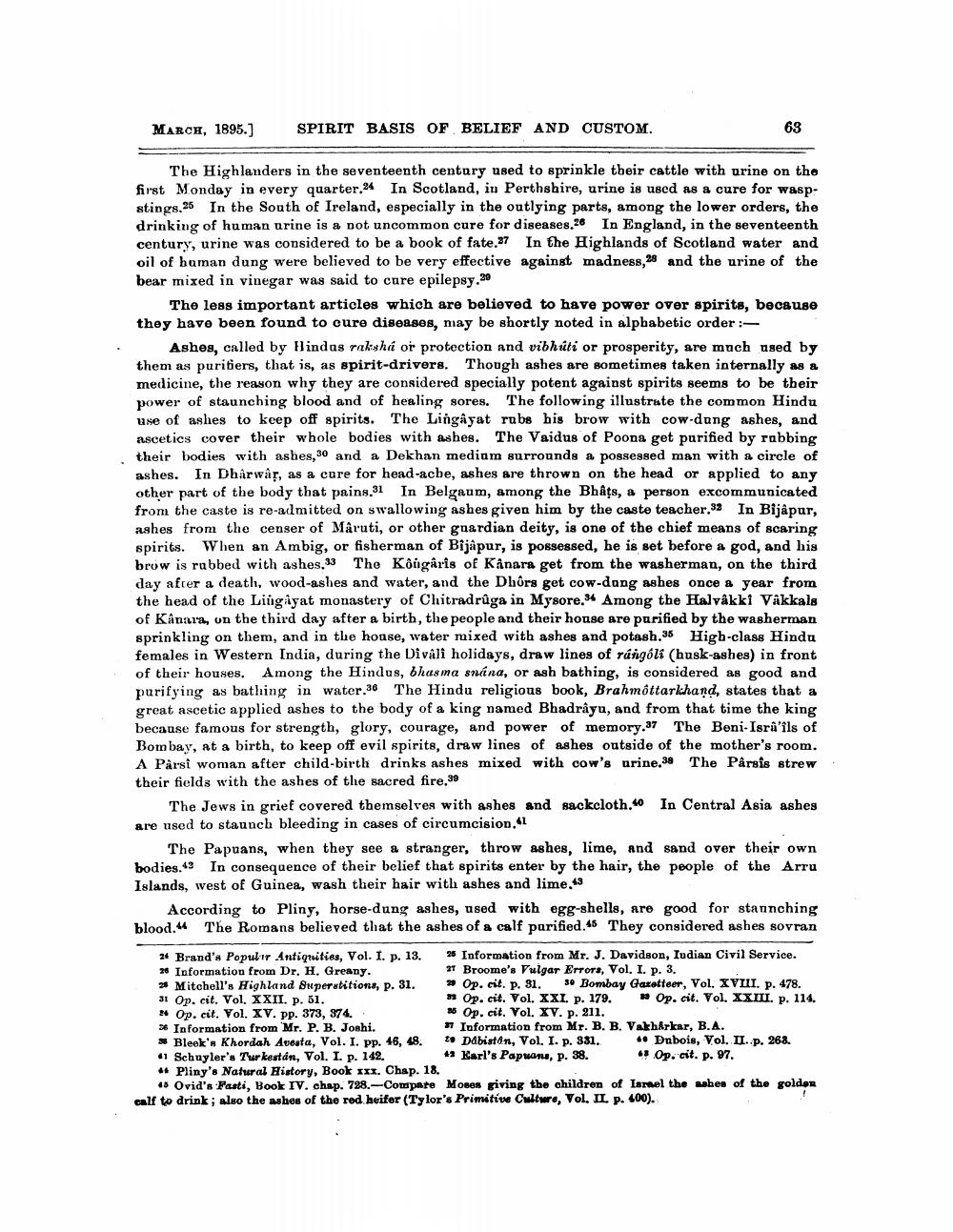________________
MARCH, 1895.)
SPIRIT BASIS OF BELIEF AND CUSTOM.
69
The Highlanders in the seventeenth century used to sprinkle their cattle with urine on the first Monday in every quarter.24 In Scotland, in Perthshire, urine is used as a cure for waspstings.25 In the South of Ireland, especially in the outlying parts, among the lower orders, the drinking of human urine is a not uncommon cure for diseases.26 In England, in the seventeenth century, urine was considered to be a book of fate.27 In the Highlands of Scotland water and oil of human dung were believed to be very effective against madness,28 and the urine of the bear mixed in vinegar was said to cure epilepsy.30
The less important articles which are believed to have power over spirits, because they have been found to cure diseases, may be shortly noted in alphabetic order :
Ashes, called by Hindas raksha or protection and vibhuti or prosperity, are much aged by them as purifiers, that is, as spirit-drivers. Though ashes are sometimes taken internally as a medicine, the reason why they are considered specially potent against spirits seems to be their power of staunching blood and of healing sores. The following illustrate the common Hindu use of ashes to keep off spirits. The Lingayat rubs his brow with cow-dang ashes, and ascetics cover their whole bodies with ashes. The Vaidus of Poona get purified by rabbing their bodies with ashes, 30 and a Dekhan mediam surrounds a possessed man with a circle of ashes. In Dharwår, as a cure for head-acbe, ashes are thrown on the head or applied to any other part of the body that pains.31 In Belgaum, among the Bhâţs, a person excommunicated from the caste is re-admitted on swallowing ashes given him by the caste teacher.32 In Bijapur, ashes from the censer of Maruti, or other guardian deity, is one of the chief means of scaring spirits. When an Ambig, or fisherman of Bijapur, is possessed, he is set before a god, and his brow is rabbed with ashes,33 The Kôngaris of Kanara get from the washerman, on the third day after a death, wood-ashes and water, and the Dhörs get cow-dang ashes once a year from the head of the Lingayat monastery of Chitradrûga in Mysore.34 Among the Halvåkki Vakkals of Kânara, on the third day after a birth, the people and their house are purified by the washerman sprinkling on them, and in the house, water mixed with ashes and potash.35 High-class Hindu females in Western India, during the Divali holidays, draw lines of rángóli (husk-ashes) in front of their houses. Among the Hindus, bhas ma snána, or ash bathing, is considered as good and purifying as bathing in water.38 The Hindu religious book, Brahmottarkhand, states that a great ascetic applied ashes to the body of a king named Bhadrâyu, and from that time the king because famous for strength, glory, courage, and power of memory.37 The Beni-Isra'ils of Bombay, at a birth, to keep off evil spirits, draw lines of ashes outside of the mother's room. A Parsi woman after child-birth drinks ashes mixed with cow's urine 3e The Pårsis strew their fields with the ashes of the sacred fire.39
The Jews in grief covered themselves with ashes and sackcloth. In Central Asia ashes are used to staunch bleeding in cases of circumcision."
The Papuans, when they see a stranger, throw ashes, lime, and sand over their own bodies. In consequence of their belief that spirits enter by the hair, the people of the Arru Islands, west of Guinea, wash their hair with ashes and lime43
According to Pliny, horse-dung ashes, used with egg-shells, are good for stannching blood. The Romans believed that the ashes of a calf purified.45 They considered ashes sovran
:
24 Brand's Populer Antiquities, Vol. I. p. 13. 26 Information from Mr. J. Davidson, Iudian Civil Service. 28 Information from Dr. H. Greany.
37 Broome's Vulgar Errors, Vol. I. p. 3. Mitchell's Highland Superstitions, p. 31. Op. cit. p. 31. 30 Bombay Gazetteer, Vol. XVIII. p. 478. 31 Op. cit. Vol. XXII. p. 51.
» Op. cit. Vol. XXI. p. 179. Op. cit. Vol. XXIII. p. 114. * Op. cit. Vol. XV. pp. 373, 374.
* Op. cit. Vol. XV. p. 211. 3 Information from Mr. P. B. Joshi.
7 Information from Mr. B. B. Vakh&rkar, B.A. * Bleek's Khordah Auesta, Vol. I. pp. 46, 48. Dabiston, Vol. I. p. 831. • Dubois, Vol. II. p. 268. #1 Schuyler's Turkestan, Vol. I. p. 142.
43 Karl's Papuans, p. 38.
Op. cit. p. 97. ** Pliny's Natural History, Book III. Chap. 18.
45 Ovid's Fasti, Book IV. chap. 798.-Compate Moses giving the children of Israel the ashes of the golden call to drink ; also the ashes of the red heifer (Tylor's Primitive Culture, Vol. II. p. 400).




